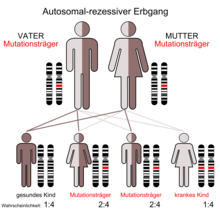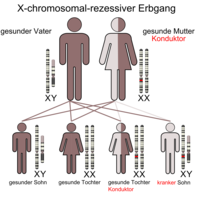Hereditary disease
- Examples of inheritance
As a hereditary disease (or genetic disease ) diseases and special features are designated either by a mutation (gene variant) in a gene ( monogenic ) or more mutations (gene variants) in different genes ( polygenic ) can be triggered and at certain Erkrankungs dispositions to lead. In this context one also speaks of monogenic or polygenetic disease .
In a narrower sense, however, only those diseases and peculiarities are considered to be hereditary diseases that are triggered by genes that have been changed atypically from the beginning and that are passed on from ancestors to their offspring through inheritance . The earliest method for researching the inheritance pathways was the pedigree analysis of family trees, in which, for example, hemophilia or color blindness , etc., occurred more frequently.
Syndromes such as forms of trisomy , in which the usual number of 46 chromosomes are not found in the human genome , can therefore not, strictly speaking, be counted as a hereditary disease, since they usually only appear spontaneously when the embryo 's cells divide and are therefore rarely inherited from a parent .
Different shapes
Hereditary diseases follow different inheritance patterns and are associated with different inheritance, recurrence and disease probabilities. A distinction is made between autosomal recessive and autosomal dominant inheritance from gonosomal and mitochondrial inheritance.
Autosomal recessive inheritance
The peculiarity only appears if there is a change ( mutation ) in both copies of a certain gene on both chromosomes , i.e. that is, if the person concerned has inherited one change from his biological father and one from his biological mother. The parents do not have to be affected, so the phenotype does not occur in every generation. The mutation does not have to be identical. If two mutations that can be distinguished by molecular genetics lead to the same loss of function in a gene, one speaks of compound heterozygosity . Examples of autosomal recessive inheritance are cystic fibrosis , albinism and phenylketonuria (PKU) (defect in phenylalanine hydroxylase).
In the case of autosomal recessive inherited diseases, it is usually a matter of loss-of-function mutations . The causes of apparent deviations in autosomal recessive inheritance are pseudo-dominance , heterogeneity , isodisomy and the fact that heterozygotes with sick children are not included. Typical examples are:
- Adrenogenital syndrome (AGS),
- Maple syrup disease ,
- Albinism ,
- Alkaptonuria ,
- Alpha1-antitrypsin deficiency ,
- Galactosemia ,
- Hereditary fructose intolerance
- Hemochromatosis
- Joubert syndrome ,
- Cretinism ,
- Short rib polydactyly syndromes (types I, II, III, IV),
- Laurence-Moon-Biedl-Bardet syndrome ( LMBB syndrome ),
- Cleft lip and palate
- Wilson disease
- Mucopolysaccharidoses (MPS),
- Cystic fibrosis or cystic fibrosis ,
- Finnish type nephrotic syndrome ,
- Peters Plus Syndrome ,
- Phenylketonuria (PKU),
- Ribbing syndrome ,
- Thalassemia and
- Xeroderma pigmentosum .
- Autosomal recessive polycystic kidney disease (ARPKD)
Autosomal dominant inheritance
Here an altered allele (alleles are the mutually and at the same time oppositely corresponding genes of a diploid chromosome set) on one of the two homologous chromosomes leads to the characteristic expression. The genetic information is available on one of the 44 autosomes and is inherited regardless of gender . So women and men are equally affected. The phenotype occurs in every generation. Examples are:
- Achondroplasia
- Apert syndrome
- Brachydactyly
- Huntington's disease ("St. Vitus's Dance")
- Ehlers-Danlos syndrome (types I – IV, VII A / B, VIII)
- Engelmann syndrome
- Erythropoietic protoporphyria
- Factor V Leiden Mutation
- Familial hypercholesterolemia
- HMSN type I ( Charcot-Marie-Tooth disease )
- Malignant hyperthermia
- Marfan's Syndrome
- Darier's disease
- Multiple cartilaginous exostoses
- Type I myotonic dystrophy
- Neurofibromatosis (Recklinghausen's disease)
- Osteogenesis imperfecta (type I)
- Piebaldism
- Polydactyly
- Retinoblastoma
- Ruvalcaba-Myhre-Smith syndrome and
- Sickle cell anemia
- Tuberous sclerosis
- Autosomal dominant polycystic kidney disease (ADPKD)
Gonosomal inheritance
Hereditary gonosomal diseases, i.e. those in which the change affects the sex chromosomes X or Y, are in most cases on the X chromosome , since the Y chromosome contains fewer genes. The X chromosome has 155 megabases, the Y chromosome 59 megabases. Using the example of X-linked inheritance , the following particularities become clear:
X-linked recessive
Girls / women are only affected when both X chromosomes are damaged, otherwise they are only carriers ( conductors ), d. This means that they can pass on the changed X chromosome to their children, but do not develop a corresponding phenotype themselves. Girls / women can often compensate for the change on one X chromosome with their second X chromosome if it is not changed. Boys / men are affected if they inherit one of the changed X chromosomes from the phenotypically healthy mother, or one of both changed X chromosomes from a phenotypically diseased mother, since boys / men definitely have one X chromosome from the Get a mother and have only this one. Boys / men are phenotypically affected more often, since girls / women compensate for the defect with the other X chromosome. Examples are glucose-6-phosphate dehydrogenase deficiency (G-6-PD deficiency), hemophilia A and B (hemophilia), Lesch-Nyhan syndrome , Fabry's disease , mucopolysaccharidosis type II, muscular dystrophy (type Duchenne, type Becker Kiener), Norrie syndrome , retinitis pigmentosa , red-green blindness , septic granulomatosis , X-SCID (severe combined immune deficiency) and ornithine transcarbamylase (OTC) deficiency ( urea cycle defect )
X-linked dominant
Boys / men are 50% affected if their mother is a carrier of a disease-causing allele on an X chromosome . If, on the other hand, both of their X chromosomes contain the disease-causing allele, all children are affected. Overall, girls / women are more often affected, as the probability of receiving an altered X chromosome is higher with two X chromosomes (one from the father, one from the mother) than with boys / men (one from the mother). Examples are familial phosphatemic rickets (also called idiopathic Debré-de-Toni-Fanconi syndrome or vitamin D-resistant rickets ), Rett syndrome and orofacio-digital syndrome type 1 .
Mitochondrial or extrachromosomal inheritance
About 0.1 percent of the DNA in a human cell is not in the nucleus, but in the mitochondria . Since egg cells, unlike sperm, have several hundred thousand mitochondria, mutations in the mitochondrial DNA are only inherited on the maternal side. The same applies to the chloroplasts of photosynthetically active organisms.
See also extrachromosomal inheritance
Diagnosis and treatment
| Classification according to ICD-10 | |
|---|---|
| Q90 - Q99 | Chromosomal abnormalities, not elsewhere classified |
| ICD-10 online (WHO version 2019) | |
If a hereditary disease is suspected, a human genetic test can provide clarity. The chromosomes are checked for numerical and structural changes. If there is an urgent suspicion of a certain genetic defect, a more extensive, complex investigation of individual gene constellations is also possible. The results can then be helpful in assessing the risk of inheritance.
If the genetic make-up is peculiar to itself, it is usually not possible to act on the causes with today's medical options. Therefore, advice is usually given regarding lifestyle, education about risk factors and symptomatic measures. These are then individual decisions, especially since it is not always a question of an illness, but often a disposition .
For a few diseases, such as B. spinal muscular atrophy, there are first attempts at therapy.
history
The concept of hereditary disease, which has only been used since the 20th century to mean genetic disease , was often used incorrectly in the first half of the 20th century , including for alleged "diseases" such as "criminal tendencies" or "antisociality". This thinking influenced sterilization programs and the euthanasia idea and found its extreme expression in German National Socialism , but was also present in many other countries such as the USA, England and France at the time. Today, only those diseases are referred to as hereditary diseases that can be defined as clearly as possible and are very likely to be due to genetic defects.
Other hereditary diseases and peculiarities
- Mayer-Rokitansky-Küster-Hauser syndrome
- Hereditary Spastic Spinal Paralysis (HSP / FSP)
- Hypophosphatasia
- Ichthyosis
- Cat's Eye Syndrome
- Retinitis pigmentosa , Usher syndrome
- Tuberous sclerosis
- Wolf-Hirschhorn Syndrome
Genetically determined disposition
Various diseases, disabilities and peculiarities are not hereditary in the sense of a classic hereditary disease, but their occurrence can be caused by a (sometimes familial) genetic disposition (disposition, susceptibility). These include B .:
- Obesity
- Allergies , various
- Alzheimer's disease
- Autoimmune diseases
- Bipolar disorder
- high blood pressure
- Creutzfeldt-Jakob disease
- depression
- Diabetes mellitus
- Big toe deviation ( Hallux valgus )
- Hair loss
- Heart defect
- Heart attack
- Various cancers (see guidelines for diagnosing genetic predisposition to cancer on the website of the German Medical Association)
- Lactose intolerance
- malignant hyperthermia
- migraine
- Multiple sclerosis (MS)
- osteoporosis
- Parkinson's Disease
- psoriasis
- rheumatism
- schizophrenia
- stroke
- deafness
- Forms of trisomy ( disposition to develop a translocation trisomy in offspring if there is a " balanced translocation " of the corresponding chromosome in parents without the respective form of trisomy)
- Vitiligo
See also
- List of hereditary diseases
- genetics
- Hereditary tumor diseases
- Prenatal diagnostics
- Preimplantation Diagnostics
- Hereditary diseases of dogs (category)
Web links
Individual evidence
- ^ Ulrich Weber: Biology upper level. Total band. Cornelsen, Berlin 2001, ISBN 3-464-04279-0 , pp. 180-182.
- ↑ Ensembl database , accessed on February 11 2017th
- ↑ JE Wraith: Ornithine Carbamoyltransferase deficiency. In: Archives of Disease in Childhood . January 2001, Volume 84, No. 1, pp. 84-88: Review. PMID 11124797 .
- ^ Werner son: Hereditary diseases. In: Werner E. Gerabek , Bernhard D. Haage, Gundolf Keil , Wolfgang Wegner (eds.): Enzyklopädie Medizingeschichte. De Gruyter, Berlin / New York 2005, ISBN 3-11-015714-4 , p. 366 f .; here: p. 366.
- ↑ Wolfgang Ayaß : "Asocial offspring is completely undesirable for the national community". The forced sterilizations of social outsiders . In: Margret Hamm (ed.): Unworthy of life - destroyed lives. Forced sterilization and "euthanasia". Publishing house for academic writings (VAS), Frankfurt am Main 2005, ISBN 3-88864-391-0 , pp. 111-119.







